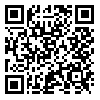Volume 8, Issue 2 (summer 2014[PERSIAN] 2014)
mljgoums 2014, 8(2): 20-26 |
Back to browse issues page
Download citation:
BibTeX | RIS | EndNote | Medlars | ProCite | Reference Manager | RefWorks
Send citation to:



BibTeX | RIS | EndNote | Medlars | ProCite | Reference Manager | RefWorks
Send citation to:
Niazi A, Koohsar F, Ghaffarifar F, Ziaei-Hezarjaribi, H, Mesgarian F, Jorjani O. Sensitivity and Specificity of Nucleic Acid Sequence-Based Amplification Method for Diagnosis of Cutaneous Leishmaniasis. mljgoums 2014; 8 (2) :20-26
URL: http://mlj.goums.ac.ir/article-1-445-en.html
URL: http://mlj.goums.ac.ir/article-1-445-en.html
1- MSc of Medical Biotechnology, Faculty of Advanced Medical Technologies, Golestan University of Medical Sciences, Gorgan, Iran
2- PhD Student of Parasitology, Laboratory Science Research Center, Golestan University of Medical Sciences, Gorgan, Iran
3- Associate Professor of Parasitology, Faculty of Medical Sciences, Tarbiat Modares University, Tehran, Iran
4- Assistant Professor of Parasitology, Deo of Parasitology, School of Medicine, Mazandaran University of Medical Sciences, Sari, Iran
5- MSc of Parasitology, Gonbad Health Center, Golestan University of Medical Sciences, Gorgan, Iran
6- Assistant Professor of Parasitology, Laboratory Science Research Center, Golestan University of Medical Sciences, Gorgan, Iran ,niaz_jorjani@yahoo.com
2- PhD Student of Parasitology, Laboratory Science Research Center, Golestan University of Medical Sciences, Gorgan, Iran
3- Associate Professor of Parasitology, Faculty of Medical Sciences, Tarbiat Modares University, Tehran, Iran
4- Assistant Professor of Parasitology, Deo of Parasitology, School of Medicine, Mazandaran University of Medical Sciences, Sari, Iran
5- MSc of Parasitology, Gonbad Health Center, Golestan University of Medical Sciences, Gorgan, Iran
6- Assistant Professor of Parasitology, Laboratory Science Research Center, Golestan University of Medical Sciences, Gorgan, Iran ,
Abstract: (14843 Views)
Abstract
Background and Objective: Culture, microscopic method is a gold standard method for identification of Lishmania parasite. The use of Molecular methods such as RT- PCR compared to microscopic methods has a higher sensitivity and specificity however, it is not widely used due to its expensive equipment and the time requested. The use of nucleic acid sequence based amplification (NASBA) method is highly valuable for diagnosis of live parasite because there is no need for to use Thermo cycler. We aimed to assess sensitivity and specificity of NASBA for molecular detection of cutaneous Leishmaniasis.
Material and Methods: First, the RNA was extracted from 28 skin biopsies suspected cutaneous Leishmaniasis. Then, by means of specific primers designed for 18srRNA region, this region was amplified using NASBA isothemal amplification. To increase the sensitivity, the product was electroforesed in TBE (IX) buffer, using Syber Gold Flourecent probes. Using specific primers, RT- PCR was conducted on the samples too.
Result: For diagnosis of Leishmania parasites, NASBA and RT-PCR had the sensitivity of 81% and 51%, respectively, and specificity of 100%.
Conclusion: NASBA isothermal method with high sensitivity and specificity can be applied for identification of cutaneous leishmaniasis.
Keywords: Cutaneous Leishmanisis, NASBA, 18S rRNA
Research Article: Original Paper |
Received: 2014/04/5 | Accepted: 2014/04/5 | Published: 2014/04/5 | ePublished: 2014/04/5
Received: 2014/04/5 | Accepted: 2014/04/5 | Published: 2014/04/5 | ePublished: 2014/04/5
Send email to the article author
| Rights and permissions | |
 |
This work is licensed under a Creative Commons Attribution-NonCommercial 4.0 International License. |

This work is licensed under a Creative Commons Attribution-NonCommercial 4.0 International License.






